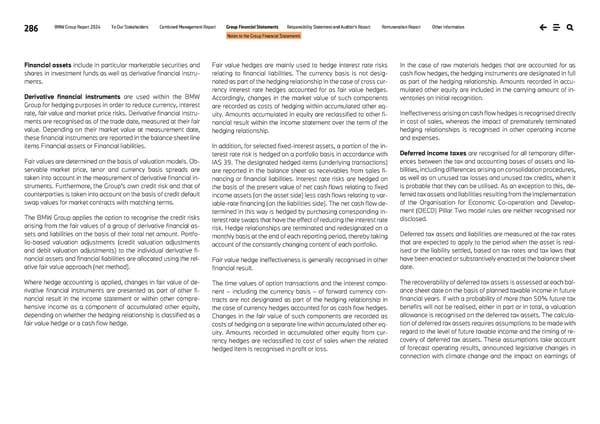286 BMW Group Report 2024 To Our Stakeholders Combined Management Report Group Financial Statements Responsibility Statement and Auditor’s Report Remuneration Report Other Information Notes to the Group Financial Statements Financial assets include in particular marketable securities and shares in investment funds as well as derivative financial instru- ments. Derivative financial instruments are used within the BMW Group for hedging purposes in order to reduce currency, interest rate, fair value and market price risks. Derivative financial instru- ments are recognised as of the trade date, measured at their fair value. Depending on their market value at measurement date, these financial instruments are reported in the balance sheet line items Financial assets or Financial liabilities. Fair values are determined on the basis of valuation models. Ob- servable market price, tenor and currency basis spreads are taken into account in the measurement of derivative financial in- struments. Furthermore, the Group's own credit risk and that of counterparties is taken into account on the basis of credit default swap values for market contracts with matching terms. The BMW Group applies the option to recognise the credit risks arising from the fair values of a group of derivative financial as- sets and liabilities on the basis of their total net amount. Portfo- lio-based valuation adjustments (credit valuation adjustments and debit valuation adjustments) to the individual derivative fi- nancial assets and financial liabilities are allocated using the rel- ative fair value approach (net method). Where hedge accounting is applied, changes in fair value of de- rivative financial instruments are presented as part of other fi- nancial result in the income statement or within other compre- hensive income as a component of accumulated other equity, depending on whether the hedging relationship is classified as a fair value hedge or a cash flow hedge. Fair value hedges are mainly used to hedge interest rate risks relating to financial liabilities. The currency basis is not desig- nated as part of the hedging relationship in the case of cross cur- rency interest rate hedges accounted for as fair value hedges. Accordingly, changes in the market value of such components are recorded as costs of hedging within accumulated other eq- uity. Amounts accumulated in equity are reclassified to other fi- nancial result within the income statement over the term of the hedging relationship. In addition, for selected fixed-interest assets, a portion of the in- terest rate risk is hedged on a portfolio basis in accordance with IAS 39. The designated hedged items (underlying transactions) are reported in the balance sheet as receivables from sales fi- nancing or financial liabilities. Interest rate risks are hedged on the basis of the present value of net cash flows relating to fixed income assets (on the asset side) less cash flows relating to var- iable-rate financing (on the liabilities side). The net cash flow de- termined in this way is hedged by purchasing corresponding in- terest rate swaps that have the effect of reducing the interest rate risk. Hedge relationships are terminated and redesignated on a monthly basis at the end of each reporting period, thereby taking account of the constantly changing content of each portfolio. Fair value hedge ineffectiveness is generally recognised in other financial result. The time values of option transactions and the interest compo- nent – including the currency basis – of forward currency con- tracts are not designated as part of the hedging relationship in the case of currency hedges accounted for as cash flow hedges. Changes in the fair value of such components are recorded as costs of hedging on a separate line within accumulated other eq- uity. Amounts recorded in accumulated other equity from cur- rency hedges are reclassified to cost of sales when the related hedged item is recognised in profit or loss. In the case of raw materials hedges that are accounted for as cash flow hedges, the hedging instruments are designated in full as part of the hedging relationship. Amounts recorded in accu- mulated other equity are included in the carrying amount of in- ventories on initial recognition. Ineffectiveness arising on cash flow hedges is recognised directly in cost of sales, whereas the impact of prematurely terminated hedging relationships is recognised in other operating income and expenses. Deferred income taxes are recognised for all temporary differ- ences between the tax and accounting bases of assets and lia- bilities, including differences arising on consolidation procedures, as well as on unused tax losses and unused tax credits, when it is probable that they can be utilised. As an exception to this, de- ferred tax assets and liabilities resulting from the implementation of the Organisation for Economic Co-operation and Develop- ment (OECD) Pillar Two model rules are neither recognised nor disclosed. Deferred tax assets and liabilities are measured at the tax rates that are expected to apply to the period when the asset is real- ised or the liability settled, based on tax rates and tax laws that have been enacted or substantively enacted at the balance sheet date. The recoverability of deferred tax assets is assessed at each bal- ance sheet date on the basis of planned taxable income in future financial years. If with a probability of more than 50% future tax benefits will not be realised, either in part or in total, a valuation allowance is recognised on the deferred tax assets. The calcula- tion of deferred tax assets requires assumptions to be made with regard to the level of future taxable income and the timing of re- covery of deferred tax assets. These assumptions take account of forecast operating results, announced legislative changes in connection with climate change and the impact on earnings of
 BMW Group Report 2024 Page 285 Page 287
BMW Group Report 2024 Page 285 Page 287